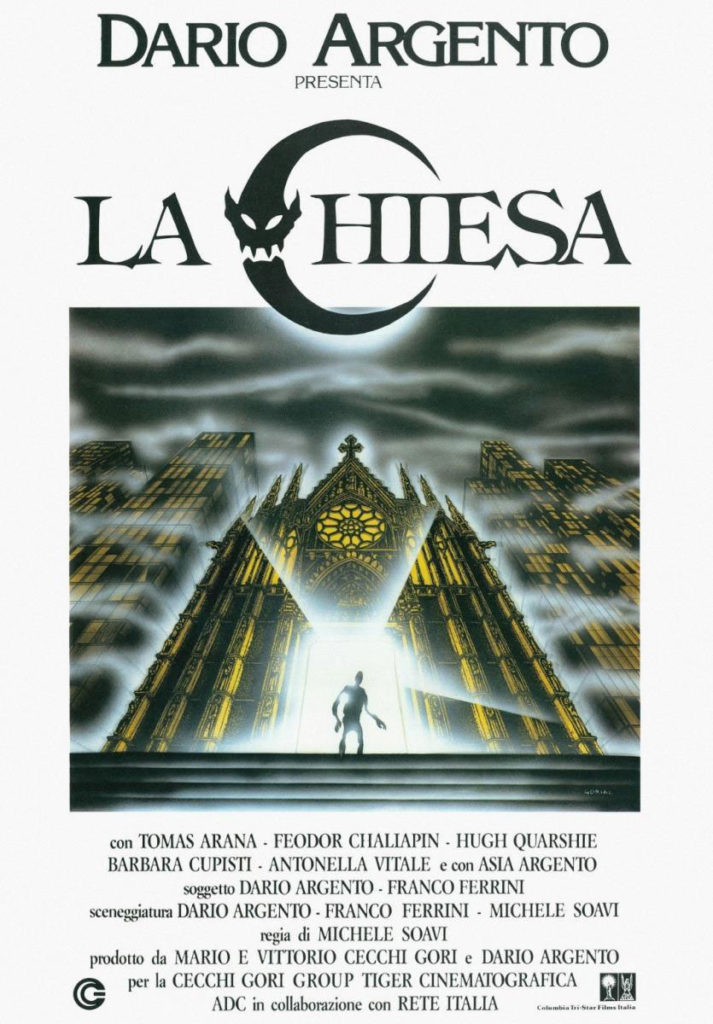After the success of Demons 2, director Lamberto Bava and producer Dario Argento had begun to collaborate on another project. But, while Bava wanted to do another entry in the Demons series, Argento did not, leading to Bava saying his farewells and Argento bringing in Michele Soavi, who had directed the second unit on a number of Argento’s films. A screenplay for the film passed through no less than eight hands, including Soavi’s. The location changed from a plane to a volcanic island and, finally, to a Gothic cathedral in the heart of a modern European city. Thus, we have The Church, from 1989.
Way back in the dark ages, Teutonic knights are led to a small camp in the forest where local peasants have been practicing witchcraft. Punishment for these heresies is swift. Every single one of the peasants is massacred and thrown into an open pit. As the peasants, possessed by demons, begin to rise from the dead, they are quickly buried. The ground is consecrated, a giant cross is placed upon it, and the local priest declares that a church shall be built upon the site, to lock away the evil, forever.
The imagery in this scene is striking, and quite savage, even though there isn’t much blood and gore. The peasants may be tools of the devil, but Soavi presents them as no more threatening in appearance than sack-wearing dirt farmers. The brutality of the attack sets the tone for the rest of the film, and shows that Soavi has a deft touch. He can use imagery to convey unsettling events and ideas without relying on pure ick.
In the present day, the church is undergoing a restoration overseen by a woman named Lisa (Barbara Cupisti). After workers in the lower levels of the church inadvertently damage the structure, she discovers an old parchment protruding from a crack in the masonry. She takes it to a librarian who is cataloging the books in the church, Evan (Tomas Arana), who grows curious about the peculiar origins of the church. This curiosity leads him down into the lower levels, where he finds the gigantic cross that has lain atop all the corpses these many centuries. He disturbs the seal on the cross, letting the evil loose in the church to terrorize visitors and clergy alike.
That is a very condensed summary of events in this 100-minute long movie. This could have been a movie with as simple of a plot, and as loose character development, as Demons. Had this film stayed in Lamberto Bava’s hands, it probably would have been just another rework of those ideas. Soavi put much more effort into story and  characters, building a film that did not rely so much on spectacle. As noted above, Soavi uses imagery to profound effect, but this is no carnival fun house movie. The frightening set pieces leading up to the final act have meaning to the story, and evoke a sense of dread. There isn’t much laughing to be done while watching this film, despite some period effects work that looks very quaint in this day of pervasive CGI.
characters, building a film that did not rely so much on spectacle. As noted above, Soavi uses imagery to profound effect, but this is no carnival fun house movie. The frightening set pieces leading up to the final act have meaning to the story, and evoke a sense of dread. There isn’t much laughing to be done while watching this film, despite some period effects work that looks very quaint in this day of pervasive CGI.
There are a number of main players to keep track of in The Church. There are the clergy, represented by Father Gus, Reverend Dominic, and the Bishop (Hugh Quarshie, Giovanni Lombardo Radice, and Feodor Chaliapin, Jr.); and the Sacristan, his wife, and his daughter (Roberto Corbiletto, Aline De Simone, and a young Asia Argento).
After the evil takes over the church, a Rube Goldberg-ian machine installed by the original builders locks these players, and a whole lot of fodder, inside. In this final act there are no more mysteries and nothing left to build to. It’s either escape or death for anyone stuck inside. This is also the most fun part of the film, as Soavi removes some of the shackles as he wraps up the story.
Many Italian horror films fall into one of two camps. Either they have a slow pace that is rough on today’s viewer, or they just throw stuff against a wall to see what sticks. Of the Italian films viewed so far for this year’s Horrorshow, The Church has the most mature and realized storytelling. I found myself being drawn into this film. In fact, I was rapt. That’s quite an achievement considering the giants of cinema that Soavi is sharing this space with this month.
The Church is a very good film. As noted above, some of the effects work is dated, but that does not matter. Some of the effects work in Close Encounters is dated, too. For someone whose horror viewing has reached well into the four figures, The Church is a welcome addition to the list, and Soavi has shown he can hang with the best.
